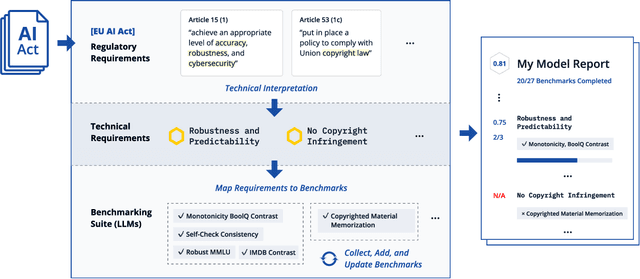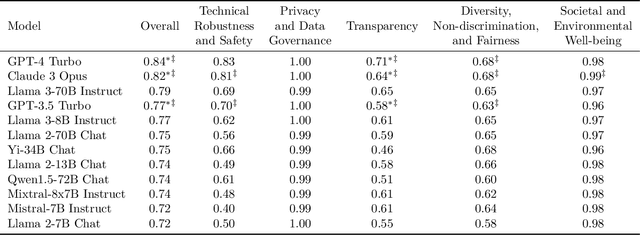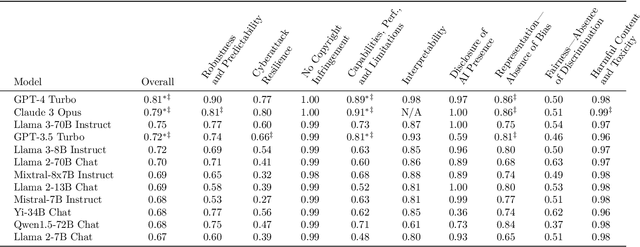Mark Vero
Fewer Weights, More Problems: A Practical Attack on LLM Pruning
Oct 09, 2025Abstract:Model pruning, i.e., removing a subset of model weights, has become a prominent approach to reducing the memory footprint of large language models (LLMs) during inference. Notably, popular inference engines, such as vLLM, enable users to conveniently prune downloaded models before they are deployed. While the utility and efficiency of pruning methods have improved significantly, the security implications of pruning remain underexplored. In this work, for the first time, we show that modern LLM pruning methods can be maliciously exploited. In particular, an adversary can construct a model that appears benign yet, once pruned, exhibits malicious behaviors. Our method is based on the idea that the adversary can compute a proxy metric that estimates how likely each parameter is to be pruned. With this information, the adversary can first inject a malicious behavior into those parameters that are unlikely to be pruned. Then, they can repair the model by using parameters that are likely to be pruned, effectively canceling out the injected behavior in the unpruned model. We demonstrate the severity of our attack through extensive evaluation on five models; after any of the pruning in vLLM are applied (Magnitude, Wanda, and SparseGPT), it consistently exhibits strong malicious behaviors in a diverse set of attack scenarios (success rates of up to $95.7\%$ for jailbreak, $98.7\%$ for benign instruction refusal, and $99.5\%$ for targeted content injection). Our results reveal a critical deployment-time security gap and underscore the urgent need for stronger security awareness in model compression.
Mind the Gap: A Practical Attack on GGUF Quantization
May 24, 2025Abstract:With the increasing size of frontier LLMs, post-training quantization has become the standard for memory-efficient deployment. Recent work has shown that basic rounding-based quantization schemes pose security risks, as they can be exploited to inject malicious behaviors into quantized models that remain hidden in full precision. However, existing attacks cannot be applied to more complex quantization methods, such as the GGUF family used in the popular ollama and llama.cpp frameworks. In this work, we address this gap by introducing the first attack on GGUF. Our key insight is that the quantization error -- the difference between the full-precision weights and their (de-)quantized version -- provides sufficient flexibility to construct malicious quantized models that appear benign in full precision. Leveraging this, we develop an attack that trains the target malicious LLM while constraining its weights based on quantization errors. We demonstrate the effectiveness of our attack on three popular LLMs across nine GGUF quantization data types on three diverse attack scenarios: insecure code generation ($\Delta$=$88.7\%$), targeted content injection ($\Delta$=$85.0\%$), and benign instruction refusal ($\Delta$=$30.1\%$). Our attack highlights that (1) the most widely used post-training quantization method is susceptible to adversarial interferences, and (2) the complexity of quantization schemes alone is insufficient as a defense.
Finetuning-Activated Backdoors in LLMs
May 22, 2025Abstract:Finetuning openly accessible Large Language Models (LLMs) has become standard practice for achieving task-specific performance improvements. Until now, finetuning has been regarded as a controlled and secure process in which training on benign datasets led to predictable behaviors. In this paper, we demonstrate for the first time that an adversary can create poisoned LLMs that initially appear benign but exhibit malicious behaviors once finetuned by downstream users. To this end, our proposed attack, FAB (Finetuning-Activated Backdoor), poisons an LLM via meta-learning techniques to simulate downstream finetuning, explicitly optimizing for the emergence of malicious behaviors in the finetuned models. At the same time, the poisoned LLM is regularized to retain general capabilities and to exhibit no malicious behaviors prior to finetuning. As a result, when users finetune the seemingly benign model on their own datasets, they unknowingly trigger its hidden backdoor behavior. We demonstrate the effectiveness of FAB across multiple LLMs and three target behaviors: unsolicited advertising, refusal, and jailbreakability. Additionally, we show that FAB-backdoors are robust to various finetuning choices made by the user (e.g., dataset, number of steps, scheduler). Our findings challenge prevailing assumptions about the security of finetuning, revealing yet another critical attack vector exploiting the complexities of LLMs.
BaxBench: Can LLMs Generate Correct and Secure Backends?
Feb 20, 2025Abstract:The automatic generation of programs has long been a fundamental challenge in computer science. Recent benchmarks have shown that large language models (LLMs) can effectively generate code at the function level, make code edits, and solve algorithmic coding tasks. However, to achieve full automation, LLMs should be able to generate production-quality, self-contained application modules. To evaluate the capabilities of LLMs in solving this challenge, we introduce BaxBench, a novel evaluation benchmark consisting of 392 tasks for the generation of backend applications. We focus on backends for three critical reasons: (i) they are practically relevant, building the core components of most modern web and cloud software, (ii) they are difficult to get right, requiring multiple functions and files to achieve the desired functionality, and (iii) they are security-critical, as they are exposed to untrusted third-parties, making secure solutions that prevent deployment-time attacks an imperative. BaxBench validates the functionality of the generated applications with comprehensive test cases, and assesses their security exposure by executing end-to-end exploits. Our experiments reveal key limitations of current LLMs in both functionality and security: (i) even the best model, OpenAI o1, achieves a mere 60% on code correctness; (ii) on average, we could successfully execute security exploits on more than half of the correct programs generated by each LLM; and (iii) in less popular backend frameworks, models further struggle to generate correct and secure applications. Progress on BaxBench signifies important steps towards autonomous and secure software development with LLMs.
COMPL-AI Framework: A Technical Interpretation and LLM Benchmarking Suite for the EU Artificial Intelligence Act
Oct 10, 2024



Abstract:The EU's Artificial Intelligence Act (AI Act) is a significant step towards responsible AI development, but lacks clear technical interpretation, making it difficult to assess models' compliance. This work presents COMPL-AI, a comprehensive framework consisting of (i) the first technical interpretation of the EU AI Act, translating its broad regulatory requirements into measurable technical requirements, with the focus on large language models (LLMs), and (ii) an open-source Act-centered benchmarking suite, based on thorough surveying and implementation of state-of-the-art LLM benchmarks. By evaluating 12 prominent LLMs in the context of COMPL-AI, we reveal shortcomings in existing models and benchmarks, particularly in areas like robustness, safety, diversity, and fairness. This work highlights the need for a shift in focus towards these aspects, encouraging balanced development of LLMs and more comprehensive regulation-aligned benchmarks. Simultaneously, COMPL-AI for the first time demonstrates the possibilities and difficulties of bringing the Act's obligations to a more concrete, technical level. As such, our work can serve as a useful first step towards having actionable recommendations for model providers, and contributes to ongoing efforts of the EU to enable application of the Act, such as the drafting of the GPAI Code of Practice.
Practical Attacks against Black-box Code Completion Engines
Aug 05, 2024Abstract:Modern code completion engines, powered by large language models, have demonstrated impressive capabilities to generate functionally correct code based on surrounding context. As these tools are extensively used by millions of developers, it is crucial to investigate their security implications. In this work, we present INSEC, a novel attack that directs code completion engines towards generating vulnerable code. In line with most commercial completion engines, such as GitHub Copilot, INSEC assumes only black-box query access to the targeted engine, without requiring any knowledge of the engine's internals. Our attack works by inserting a malicious attack string as a short comment in the completion input. To derive the attack string, we design a series of specialized initialization schemes and an optimization procedure for further refinement. We demonstrate the strength of INSEC not only on state-of-the-art open-source models but also on black-box commercial services such as the OpenAI API and GitHub Copilot. On a comprehensive set of security-critical test cases covering 16 CWEs across 5 programming languages, INSEC significantly increases the likelihood of the considered completion engines in generating unsafe code by >50% in absolute, while maintaining the ability in producing functionally correct code. At the same time, our attack has low resource requirements, and can be developed for a cost of well under ten USD on commodity hardware.
A Synthetic Dataset for Personal Attribute Inference
Jun 11, 2024Abstract:Recently, powerful Large Language Models (LLMs) have become easily accessible to hundreds of millions of users worldwide. However, their strong capabilities and vast world knowledge do not come without associated privacy risks. In this work, we focus on the emerging privacy threat LLMs pose - the ability to accurately infer personal information from online texts. Despite the growing importance of LLM-based author profiling, research in this area has been hampered by a lack of suitable public datasets, largely due to ethical and privacy concerns associated with real personal data. In this work, we take two steps to address this problem: (i) we construct a simulation framework for the popular social media platform Reddit using LLM agents seeded with synthetic personal profiles; (ii) using this framework, we generate SynthPAI, a diverse synthetic dataset of over 7800 comments manually labeled for personal attributes. We validate our dataset with a human study showing that humans barely outperform random guessing on the task of distinguishing our synthetic comments from real ones. Further, we verify that our dataset enables meaningful personal attribute inference research by showing across 18 state-of-the-art LLMs that our synthetic comments allow us to draw the same conclusions as real-world data. Together, this indicates that our dataset and pipeline provide a strong and privacy-preserving basis for future research toward understanding and mitigating the inference-based privacy threats LLMs pose.
Exploiting LLM Quantization
May 28, 2024Abstract:Quantization leverages lower-precision weights to reduce the memory usage of large language models (LLMs) and is a key technique for enabling their deployment on commodity hardware. While LLM quantization's impact on utility has been extensively explored, this work for the first time studies its adverse effects from a security perspective. We reveal that widely used quantization methods can be exploited to produce a harmful quantized LLM, even though the full-precision counterpart appears benign, potentially tricking users into deploying the malicious quantized model. We demonstrate this threat using a three-staged attack framework: (i) first, we obtain a malicious LLM through fine-tuning on an adversarial task; (ii) next, we quantize the malicious model and calculate constraints that characterize all full-precision models that map to the same quantized model; (iii) finally, using projected gradient descent, we tune out the poisoned behavior from the full-precision model while ensuring that its weights satisfy the constraints computed in step (ii). This procedure results in an LLM that exhibits benign behavior in full precision but when quantized, it follows the adversarial behavior injected in step (i). We experimentally demonstrate the feasibility and severity of such an attack across three diverse scenarios: vulnerable code generation, content injection, and over-refusal attack. In practice, the adversary could host the resulting full-precision model on an LLM community hub such as Hugging Face, exposing millions of users to the threat of deploying its malicious quantized version on their devices.
Back to the Drawing Board for Fair Representation Learning
May 28, 2024Abstract:The goal of Fair Representation Learning (FRL) is to mitigate biases in machine learning models by learning data representations that enable high accuracy on downstream tasks while minimizing discrimination based on sensitive attributes. The evaluation of FRL methods in many recent works primarily focuses on the tradeoff between downstream fairness and accuracy with respect to a single task that was used to approximate the utility of representations during training (proxy task). This incentivizes retaining only features relevant to the proxy task while discarding all other information. In extreme cases, this can cause the learned representations to collapse to a trivial, binary value, rendering them unusable in transfer settings. In this work, we argue that this approach is fundamentally mismatched with the original motivation of FRL, which arises from settings with many downstream tasks unknown at training time (transfer tasks). To remedy this, we propose to refocus the evaluation protocol of FRL methods primarily around the performance on transfer tasks. A key challenge when conducting such an evaluation is the lack of adequate benchmarks. We address this by formulating four criteria that a suitable evaluation procedure should fulfill. Based on these, we propose TransFair, a benchmark that satisfies these criteria, consisting of novel variations of popular FRL datasets with carefully calibrated transfer tasks. In this setting, we reevaluate state-of-the-art FRL methods, observing that they often overfit to the proxy task, which causes them to underperform on certain transfer tasks. We further highlight the importance of task-agnostic learning signals for FRL methods, as they can lead to more transferrable representations.
Private Attribute Inference from Images with Vision-Language Models
Apr 16, 2024Abstract:As large language models (LLMs) become ubiquitous in our daily tasks and digital interactions, associated privacy risks are increasingly in focus. While LLM privacy research has primarily focused on the leakage of model training data, it has recently been shown that the increase in models' capabilities has enabled LLMs to make accurate privacy-infringing inferences from previously unseen texts. With the rise of multimodal vision-language models (VLMs), capable of understanding both images and text, a pertinent question is whether such results transfer to the previously unexplored domain of benign images posted online. To investigate the risks associated with the image reasoning capabilities of newly emerging VLMs, we compile an image dataset with human-annotated labels of the image owner's personal attributes. In order to understand the additional privacy risk posed by VLMs beyond traditional human attribute recognition, our dataset consists of images where the inferable private attributes do not stem from direct depictions of humans. On this dataset, we evaluate the inferential capabilities of 7 state-of-the-art VLMs, finding that they can infer various personal attributes at up to 77.6% accuracy. Concerningly, we observe that accuracy scales with the general capabilities of the models, implying that future models can be misused as stronger adversaries, establishing an imperative for the development of adequate defenses.
 Add to Chrome
Add to Chrome Add to Firefox
Add to Firefox Add to Edge
Add to Edge